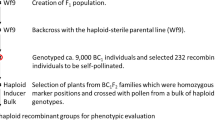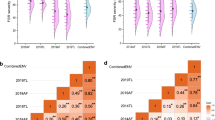Abstract
Segregation distortion analysis in plant breeding is highly important because deviation factors are occasionally serious barriers for introgression of genes of interest into cultivated species. Also, the identification of major QTLs by high linkage disequilibrium is highly useful for breeders in order for crop improvement programs and the further fine mapping of particular genes. Consequently, simultaneous consideration of segregation distortion and linkage disequilibrium leads to developing fertile hybrids and normal inheritance of agronomically favorable genes. Hence, the goal of this study was to investigate genomic regions known to contain fragrance quantitative trait loci (QTLs) in terms of segregation distortion and linkage disequilibrium pattern, and to seek for a possible relationship between them using codominant markers on chromosomes 3, 4, and 8 in a set containing 189 F2 progenies. For the first time, we discovered the presence and extent of segregation distortion and linkage disequilibrium across the fragrance chromosomal areas of rice. The high frequency of skewed allelic segregations in the chromosomes 3 and 4 supports reports of possible gametic selection (ga) and hybrid sterility (S) genes. Finally, the highest linkage disequilibrium values, the lowest recombination frequency, and the shortest distances were observed in the chromosomal regions without segregation distortion. High linkage disequilibrium correlations between markers at short distances may show that such markers can maintain high linkage disequilibrium with linked QTLs and are influential for both MAS and QTL mapping analysis. Moreover, an indirect relationship between segregation distortion and linkage disequilibrium was detected, and thus linkage disequilibrium maps were introduced as useful diagnostic tools for segregation distortion.





Similar content being viewed by others
References
Alheit KV, Reif JC, Maurer HP, Hahn V, Weissmann EA, Miedaner T, Würschum T (2011) Detection of segregation distortion loci in triticale (x Triticosecale Wittmack) based on a high-density DArT marker consensus genetic linkage map. BMC Genomics 12:380
Aluko G, Martinez C, Tohme J, Castano C, Bergman C, Oard JH (2004) QTL mapping of grain quality traits from the interspecific cross Oryza sativa × O. glaberrima. Theor Appl Genet 109:630–639
Amarawathi Y, Singh R, Singh AK, Singh VP, Mohapatra T, Sharma TR, Singh NK (2008) Mapping of quantitative trait loci for basmati quality traits in rice (Oryza sativa L.). Mol Breed 21:49–65
Antonio BA, Inoue T, Kajiya H, Nagamura Y, Kurata N, Minobe Y et al (1996) Comparison of genetic distance and order of DNA markers in five populations of rice. Genome 39:946–956
Baumbach J, Rogers JP, Slattery RA et al (2012) Segregation distortion in a region containing a male-sterility, female-sterility locus in soybean. Plant Sci 195:151–156
Berloo RV (2008) GGT 2.0: versatile software for visualization and analysis of genetic data. J Hered 99:232–236
Bradbury LM (2009) Identification of the gene responsible for fragrance in rice and characterisation of the enzyme transcribed from this gene and its homologs. Dissertation, Southern Cross University
Bradbury LM, Henry RJ, Jin Q, Reinke RF, Waters DL (2005) A perfect marker for fragrance genotyping in rice. Mol Breed 16:279–283
Broman KW, Sen S (2009) A guide to QTL mapping with R/qtl. Springer, New York
Broman KW, Wu H, Sen Ś, Churchill GA (2003) R/qtl: QTL mapping in experimental crosses. Bioinformatics 19:889–890
Brummer EC, Bouton JH, Kochert G (1993) Development of an RFLP map in diploid alfalfa. Theor Appl Genet 86:329–332
Caicedo AL, Williamson SH, Hernandez RD et al (2007) Genome-wide patterns of nucleotide polymorphism in domesticated rice. PLoS Genet 3:e163
Carlborg Ö, Jacobsson L, Åhgren P, Siegel P, Andersson L (2006) Epistasis and the release of genetic variation during long-term selection. Nat Genet 38:418–420
Collins AR (2007) Linkage disequilibrium and association mapping: an introduction. In: Collins AR (ed) Linkage disequilibrium and association mapping. Methods in molecular biology, vol 376. Humana Press, Totowa, pp 1–15
Dawson E, Abecasis GR, Bumpstead S et al (2002) A first-generation linkage disequilibrium map of human chromosome 22. Nature 418:544–548
Feuillet C, Keller B (2002) Comparative genomics in the grass family: molecular characterization of grass genome structure and evolution. Ann Bot 89:3–10
Garris AJ, McCouch SR, Kresovich S (2003) Population structure and its effect on haplotype diversity and linkage disequilibrium surrounding the xa5 locus of rice (Oryza sativa L.). Genetics 165:759–769
Gawel N, Jarret R (1991) A modified CTAB DNA extraction procedure for Musa and Ipomoea. Plant Mol Biol Rep 9:262–266
Golestan Hashemi FS, Rafii MY, Ismail MR et al (2013) Biochemical, genetic and molecular advances of fragrance characteristics in rice. Crit Rev Plant Sci 32:445–457
Gupta PK, Rustgi S, Kulwal PL (2005) Linkage disequilibrium and association studies in higher plants: present status and future prospects. Plant Mol Biol 57:461–485
Harushima Y, Kurata N, Yano M, Nagamura Y, Sasaki T, Minobe Y, Nakagahra M (1996) Detection of segregation distortions in an indica-japonica rice cross using a high-resolution molecular map. Theor Appl Genet 92:145–150
Knox M, Ellis T (2002) Excess heterozygosity contributes to genetic map expansion in pea recombinant inbred populations. Genetics 162:861–873
Kumar S, Gill BS, Faris JD (2007) Identification and characterization of segregation distortion loci along chromosome 5B in tetraploid wheat. Mol Genet Genomics 278:187–196
Lorieux M, Petrov M, Huang N, Guiderdoni E, Ghesquière A (1996) Aroma in rice: genetic analysis of a quantitative trait. Theor Appl Genet 93:1145–1151
Lu H, Romero-Severson J, Bernardo R (2002) Chromosomal regions associated with segregation distortion in maize. Theor Appl Genet 105:622–628
Lyttle T (1991) Segregation distorters. Annu Rev Genet 25:511–557
Matsushita S, Iseki T, Fukuta Y, Araki E, Kobayashi S, Osaki M, Yamagishi M (2003) Characterization of segregation distortion on chromosome 3 induced in wide hybridization between indica and japonica type rice varieties. Euphytica 134:27–32
McCouch SR, Teytelman L, Xu Y et al (2002) Development and mapping of 2240 new SSR markers for rice (Oryza sativa L.). DNA Res 9:199–207
Nakagahra M (1972) Genetic mechanism on the distorted segregation of marker genes belonging to the eleventh linkage group in cultivated rice. Jap J Breed 22:232–238
Ollitrault P, Terol J, Chen C et al (2012) A reference genetic map of C. clementina hort. ex Tan.; citrus evolution inferences from comparative mapping. BMC Genomics 13:593
Ostberg CO, Hauser L, Pritchard VL, Garza JC, Naish KA (2013) Chromosome rearrangements, recombination suppression, and limited segregation distortion in hybrids between Yellowstone cutthroat trout (Oncorhynchus clarkii bouvieri) and rainbow trout (O. mykiss). BMC Genomics 14:570
Padhukasahasram B, Marjoram P, Nordborg M (2004) Estimating the rate of gene conversion on human chromosome 21. Am J Hum Genet 75:386–397
Paillard S, Schnurbusch T, Winzeler M et al (2003) An integrative genetic linkage map of winter wheat (Triticum aestivum L.). Theor Appl Genet 107:1235–1242
Paterson AH, Lander ES, Hewitt JD, Peterson S, Lincoln SE, Tanksley SD (1988) Resolution of quantitative traits into Mendelian factors by using a complete linkage map of restriction fragment length polymorphisms. Nature 335:721–726
Pinson S (1994) Inheritance of aroma in six rice cultivars. Crop Sci 34:1151–1157
Rakshit S, Rakshit A, Matsumura H et al (2007) Large-scale DNA polymorphism study of Oryza sativa and O. rufipogon reveals the origin and divergence of Asian rice. Theor Appl Genet 114:731–743
Reflinur Kim B, Jang SM et al (2014) Analysis of segregation distortion and its relationship to hybrid barriers in rice. Rice 7:3
Sakthivel K, Sundaram R, Shobha Rani N, Balachandran S, Neeraja C (2009) Genetic and molecular basis of fragrance in rice. Biotechnol Adv 27:468–473
Shanmugavadivel PS, Mithra SVA, Dokku P et al (2013) Mapping quantitative trait loci (QTL) for grain size in rice using a RIL population from Basmati × indica cross showing high segregation distortion. Euphytica 194:401–416
Soto-Cerda BJ, Cloutier S (2012) Association mapping in plant genomes. In: Caliskan M (ed) Genetic diversity in Plants. InTech, Rijeka, pp 29–54
Sun S, Gao FY, Lu XJ, Wu XJ, Wang XD, Ren GJ, Luo H (2008) Genetic analysis and gene fine mapping of aroma in rice (Oryza sativa L. Cyperales, Poaceae). Genet Mol Biol 31:532–538
R Core Team (2011) R: A language and environment for statistical computing. R Foundation for Statistical Computing, Vienna. http://cranr-project.org
Temnykh S, Park WD, Ayres N et al (2000) Mapping and genome organization of microsatellite sequences in rice (Oryza sativa L.). Theor Appl Genet 100:697–712
Wang S, Tan Y, Tan X, Zhang Z, Wen J, Kou S (2009) Segregation distortion detected in six rice F2 populations generated from reciprocal hybrids at three altitudes. Genet Res 91:345–353
Wu YP, Ko PY, Lee WC et al (2010) Comparative analyses of linkage maps and segregation distortion of two F2 populations derived from japonica crossed with indica rice. Hereditas 147:225–236
Xu S (2008) Quantitative trait locus mapping can benefit from segregation distortion. Genetics 180:2201–2208
Xu S, Hu Z (2009) Mapping quantitative trait loci using distorted markers. Int J Plant Genomics. doi:10.1155/2009/410825
Xu Y, Zhu L, Xiao J, Huang N, McCouch SR (1997) Chromosomal regions associated with segregation distortion of molecular markers in F2, backcross, doubled haploid, and recombinant inbred populations in rice (Oryza sativa L.). Mol Gen Genet 253:535–545
Yi M, Nwe KT, Vanavichit A, Chai-arree W, Toojinda T (2009) Marker assisted backcross breeding to improve cooking quality traits in Myanmar rice cultivar Manawthukha. Field Crops Res 113:178–186
Zhang H, Meltzer P, Davis S (2013) RCircos: an R package for Circos 2D track plots. BMC Bioinform 14:1–5
Zhao B, Deng QM, Zhang QJ, Li JQ, Ye SP, Liang YS, Peng Y, Li P (2006) Analysis of segregation distortion of molecular markers in F2 population of rice. Acta Genet Sin 33:449–457
Zhao H, Nettleton D, Dekkers J (2007) Evaluation of linkage disequilibrium measures between multi-allelic markers as predictors of linkage disequilibrium between single nucleotide polymorphisms. Genet Res 89:1–6
Zhu C, Wang C, Zhang YM (2007) Modeling segregation distortion for viability selection I. Reconstruction of linkage maps with distorted markers. Theor Appl Genet 114:295–305
Acknowledgments
The authors express their acknowledgements of the Long-term Research Grant Scheme (LRGS), Food Security Project, Ministry of Higher Education, Malaysia, for the financial support to conduct activities on rice research program.
Author information
Authors and Affiliations
Corresponding authors
Rights and permissions
About this article
Cite this article
Golestan Hashemi, F.S., Rafii, M.Y., Ismail, M.R. et al. Comparative mapping and discovery of segregation distortion and linkage disequilibrium across the known fragrance chromosomal regions in a rice F2 population. Euphytica 204, 557–569 (2015). https://doi.org/10.1007/s10681-014-1322-y
Received:
Accepted:
Published:
Issue Date:
DOI: https://doi.org/10.1007/s10681-014-1322-y




